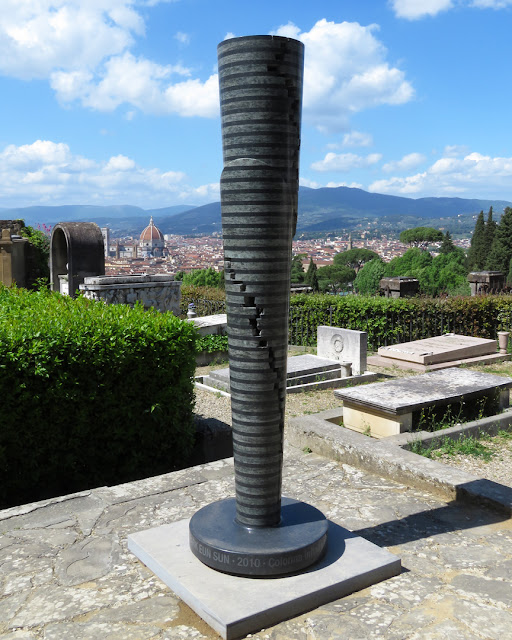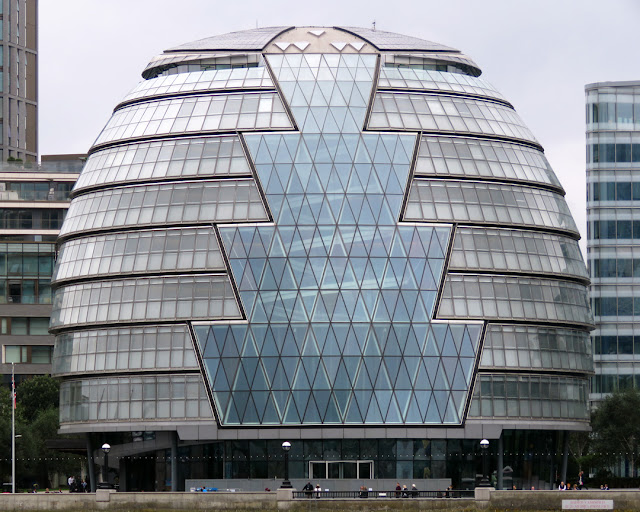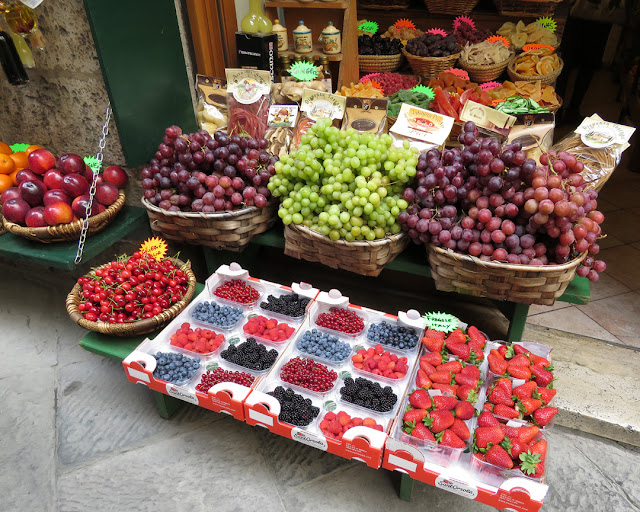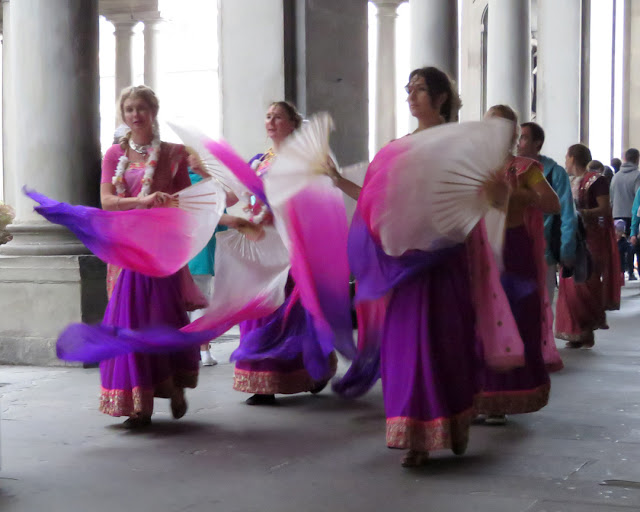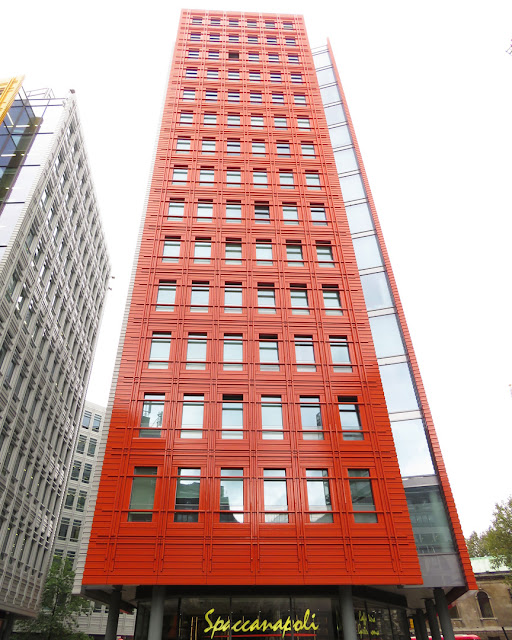Friday, June 30, 2017
Thursday, June 29, 2017
Equità
“Equità” (Equity) by Vincenzo Danti, 1566
Piazzale degli Uffizi
Florence, April 2017
“Vincenzo Danti was born in Perugia in 1530. At the beginning of his career, he followed his father's footsteps and studied as a goldsmith. In 1555, at just 25 years old, he creates the large bronze statue of Pope Julius III which is placed just outside the Cathedral in Perugia. Danti lives for a while in Rome where he further deepens his knowledge of the art of goldsmith and studies carefully the works of the great master, Michelangelo. The figure of Buonarroti is extremely important for Danti, so much important that he is later nicknamed as Michelangelo's apprentice, even though it is likely they never even met. Thanks to his fame of an ‘infant prodigy’, he is invited to work for the Medici family in Florence. It is Cosimo I de' Medici himself that invites him upon advice by Sforza Almeni, who is Medici's great counselor and from Perugia himself. Danti works in Florence from 1557 to 1573. During these years he becomes a famous and well-appreciated Renaissance artist by creating some masterpieces such as Honour Triumphs over Falsehood (today in the Bargello museum), Virgin with Child in Santa Croce and the two statues of Equity and Rigor at the Uffizi Gallery. Despite his success, he leaves Florence in 1573 and goes back to Perugia where he dies three years later in 1576.” (Vincenzo Danti, Michelangelo's greatest apprentice, Visit Florence)
Wednesday, June 28, 2017
Barcelona Cathedral
Catedral de la Santa Creu i Santa Eulàlia
(Cathedral of the Holy Cross and Saint Eulalia)
Pla de la Seu
Barcelona, March 2017
“The Cathedral of the Holy Cross and Saint Eulalia (Catalan: Catedral de la Santa Creu i Santa Eulàlia, Spanish: Catedral de la Santa Cruz y Santa Eulalia), also known as Barcelona Cathedral, is the Gothic cathedral and seat of the Archbishop of Barcelona, Spain. The cathedral was constructed from the 13th to 15th centuries, with the principal work done in the 14th century. The cloister, which encloses the Well of the Geese (Font de les Oques) was completed in 1448. In the late 19th century, the neo-Gothic façade was constructed over the nondescript exterior that was common to Catalan churches. The roof is notable for its gargoyles, featuring a wide range of animals, both domestic and mythical.” (Barcelona Cathedral, Wikipedia)
Tuesday, June 27, 2017
Palazzo San Giorgio
Palazzo San Giorgio
Piazza Caricamento
Genoa, April 2016
“The Palazzo San Giorgio or Palace of St. George (also known as the Palazzo delle Compere di San Giorgio) is a palace in Genoa, Italy. It is situated in the Piazza Caricamento. The palace was built in 1260 by Guglielmo Boccanegra, uncle of Simone Boccanegra, the first Doge of Genoa. For the construction of the new palace, materials were used from the demolition of the Venetian embassy in Constantinople, having been obtained from Byzantine Emperor Michael VIII as a reward for Genoese aid against the Latin Empire. Stone lions, the emblem of Venice's patron St Mark were displayed as trophies on the facade by her bitter rival, the Republic of Genoa. The palace was intended — through the creation of a civil-political center — to separate and elevate the temporal power of the Republic's government from the religious power of the clergy, centered on the Cathedral of San Lorenzo. In 1262, Guglielmo Boccanegra was deposed and forced into exile. The palace was used for a time as a prison; Marco Polo was its most famous resident and it was there that he dictated his memoirs to Rustichello of Pisa. In the 15th century, the palace became home to the Bank of Saint George.” (Palazzo San Giorgio, Wikipedia)
Monday, June 26, 2017
Angel Musician with Flute
“Angel Musician with Flute” by Carl Milles, 1991
Thomas More Square, Wapping
London, September 2016
“The Swedish sculptor Carl Milles (1875-1955) began creating angel musicians in 1918 on the death of his closest friend, the composer Emil Sjögren in 1918. The original Angel Musician with Flute was a memorial statue, but it was followed by angels with trumpet, tuba, panpipe and clarinet. They stand, singly and in small bands, in gardens mainly in Sweden and the US, where Milles was a teacher for many years. His naked figures often offended delicate American sensibilities - he used to say that he had a ‘fig-leaf maker on retainer’. Milles worked for a while in the studio of Auguste Rodin. When he left he feared being written-off as a mere imitator of the great man, so he deliberately struck out on his own path to create figures that seem to fly or float, supported by discrete steel pillars. This one was placed in Thomas More Square when it was built in 1991, unveiled by art collector and modern architecture fan Lord Palumbo.” (Thomas More Square E1, Ornamental Passions)
Sunday, June 25, 2017
Saturday, June 24, 2017
Novotel Paris Tour Eiffel
Hôtel Novotel Paris Tour Eiffel (hôtel Nikko)
Quai de Grenelle
Front de Seine (also known as Beaugrenelle)
Quartier de Grenelle, 15th arrondissement
Paris, July 2014
“The Front de Seine district is the result of an urban planning project from the 1970s. It includes about 20 towers reaching nearly 100 m of height built all around an elevated esplanade. That esplanade is paved with frescos that can be seen only from the elevated floors of the towers. As opposed to Italie 13, the design of the towers is much more varied. The Hôtel Novotel Paris-Tour Eiffel (formerly known as Hôtel Nikkō), for instance, has red-encircled windows, while the Tour Totem consists of a stack of several glassed-blocks. A newly redesigned shopping centre, the Centre commercial Beaugrenelle has opened in 2013.” (Wikipedia)
Friday, June 23, 2017
Arco del Meloncello
Detail of the Arco del Meloncello, by Carlo Francesco Dotti, 1732
Via Saragozza
Bologna, June 2015
“The Arco del Meloncello is an 18th-century Rococo structure in Bologna, that forms a pedestrian portico over the road (hence an arch); it is part of the Portico di San Luca, a long arcade that sheltered the walk from the Cathedral of Bologna to the hillside Sanctuary of San Luca, Bologna. It lies beyond the gates of the Porta Saragozza, outside the former city walls of Bologna. The arch solved the problem of a site where two roads intersected at right angles, and allowed the foot traffic of the pilgrims to proceed above the road, Via Saragozza, uninterrupted. The architect was Carlo Francesco Dotti won the commission during a competition in 1714, and created the scenographic arrangement with the help of Francesco Galli Bibiena during 1721 to 1732. In the early twentieth century, in a project supervised by Tito Azzolino, the arch was raised a few meters to allow passage of a train underneath.” (Arco del Meloncello, Wikipedia)
Thursday, June 22, 2017
Red Heart
Red heart cycle stand by Graham McLoughlin
Beak Street, Soho
London, September 2016
“Cyclehoop teamed up with Hackney based artist Graham McLoughlin and the British Heart Foundation to place 14 #HeartsOfLondon cycle stands across Central London. This installation is designed to promote cycling in the city and celebrate British design, but more importantly, raise awareness for the work of the British Heart Foundation. Accompanying the heart-shaped hoops are a sticker, stating ‘Share the love by making a donation to the British Heart Foundation — all you need to do is text ‘LNDN86 £5’ to 70070.’” (Lovehoops Installed around London, CycleHoop)
Wednesday, June 21, 2017
Infinite Column
“Colonna infinita” (Infinite Column) by Park Eun-sun, 2016
San Miniato al Monte (St. Minias on the Mountain)
Florence, April 2017
“The sculptures by Park Eun Sun, who has previously exhibited in various Italian landmarks and been awarded for spreading Korean culture abroad, merge notions of the colourful East and the elegance of Italian style. Columns, spheres and cubes carved out of striped marble strive to emphasize the Romanesque style that lives on in Tuscany today, as well as representing the eastern concept of perfect balance. Each work contains a fracture in one way or another, symbolizing thoughts, neurosis, fears and anger, although the sculptures continue to stand strong.” (Park Eun Sun exhibition in Florence, The Florentine)
Tuesday, June 20, 2017
Palau Sant Jordi
Palau Sant Jordi by Arata Isozaki, 1990
Anella Olímpica (Olympic Ring)
Passeig Olímpic, Montjuïc
Barcelona, March 2017
“Palau Sant Jordi (St. George's Palace) is an indoor sporting arena and multi-purpose installation that is part of the Olympic Ring complex located in Barcelona, Catalonia, Spain. Designed by the Japanese architect Arata Isozaki, it was opened in 1990. The maximum seating capacity of the arena is 16,670 for basketball, and 24,000 for musical events. It is the largest indoor arena in Spain. The Palau Sant Jordi was one of the main venues of the 1992 Summer Olympics hosting the artistic gymnastics, handball final, and volleyball final events. Today, it is used for all kinds of indoor sport events as well as for concerts and other cultural activities, due to its great flexibility.” (Palau Sant Jordi, Wikipedia)
Monday, June 19, 2017
Sunday, June 18, 2017
City Hall
City Hall by Foster and Partners, 2002
The Queen's Walk, Southwark
London, September 2016
“City Hall was constructed at a cost of £43 million on a site formerly occupied by wharves serving the Pool of London. The building does not belong to the GLA but is leased under a 25-year rent. Despite its name, City Hall is not in and does not serve a city (according to UK law), which often adds to the confusion of Greater London with the City of London, which has its headquarters at Guildhall. In June 2011, Mayor Boris Johnson announced that for the duration of the London 2012 Olympic Games, the building would be called London House.” (City Hall, Wikipedia)
Saturday, June 17, 2017
Friday, June 16, 2017
GSW Headquarters
Detail of a facade, GSW Headquarters by Sauerbruch Hutton, 1999
Kochstrasse, Kreuzberg
Berlin, September 2011
Thursday, June 15, 2017
Wednesday, June 14, 2017
Tuesday, June 13, 2017
Hare Krishna Dancers
Hare Krishna dancers
Galleria degli Uffizi (Uffizi Gallery)
Piazzale degli Uffizi
Florence, April 2017
Monday, June 12, 2017
Monk Parakeet
Monk parakeet on a tree
Pla de Palau
Barcelona, March 2017
“Seven species of parrot are thriving right here in urban Barcelona—the highest number of parrot species in any European city. ‘We don’t think temperature is a factor,’ said Abel Julien of the Institut Català d’Ornitologia, who has studied birds in Catalunya for more than 30 years and works as a nature tour guide. ‘They will stay in their colonised environments provided there is enough food for them throughout the year.’ First spotted in the city in 1975, their numbers were estimated at a mere 50, but with a vertiginous growth rate, there are now thought to be more than 10,000 parrots living in the Barcelona metropolitan area. Among the species in Barcelona are monk parrots, named thus for the hood-like markings on their crown and nape of bright-green and grey feathers. At less than 30 centimetres in length, they are considered tiny for a parrot. Larger than the monks—think parrot-on-pirate-shoulder size—rose-ringed parakeets have powder-blue napes, tropical-green breasts and flesh-coloured or scarlet bills.” (Birds of a feather: Barcelona's tropical parrots, Metropolitan Barcelona)
Sunday, June 11, 2017
Scilicet
“Scilicet” by Félix Joffre, 1956
Monument to the twinning of Rome and Paris
Via Parigi
Rome, April 2013
“In front of the Hall is a gift (1961) from the twin-city of Paris (since 1956), a Roman column with the bronze caravel on the top (heraldic symbol of Paris). Behind the hall along Via Parigi conspicuous remains of buildings demolished to make way for the Baths. It also contains works that came to light during the excavation works performed in Rome and in its surroundings, such as the Venus of Cyrene or the Girl from Antium, realized by Greek sculptors of the fifth century BC. Inside the building the visitor can admire frescoes of the Republican Age.” (Octagonal Hall of Diocletian Bath, RomeTour.org)
Saturday, June 10, 2017
Heirloom Tomatoes
Heirloom tomatoes (heritage tomatoes)
Holland Street, Bankside, Southwark
London, September 2016
“An heirloom tomato (also called heritage tomato in the UK) is an open-pollinated (non-hybrid) heirloom cultivar of tomato. Heirloom tomatoes have become increasingly popular and more readily available in recent years. According to tomato experts Craig LeHoullier and Carolyn Male, heirloom tomatoes can be classified into four categories: family heirlooms, commercial heirlooms, mystery heirlooms, and created heirlooms. They are grown for a variety of reasons, such as for food, historical interest, access to wider varieties, and by people who wish to save seeds from year to year, as well as for their taste, which is widely perceived to be better than ‘conventional’ tomatoes. They usually have a shorter shelf life, but are generally more disease resistant than most commercial tomatoes, except for specific disease(s), for which a commercial hybrid was bred to be resistant.” (Heirloom tomato)
Friday, June 9, 2017
Underpass of the Cure
Sottopassaggio delle Cure (Underpass of the Cure)
Piazza delle Cure
Florence, April 2017
“Underneath the sottopassaggio in Piazza delle Cure is an art exhibit unlike any other in Florence. The admission is free, the hours of operation are up to the visitors, the curator is self-appointed and, best of all, there are no lines. Ten years ago, local residents would suggest that you take the long way around the passage. This space was occupied by the homeless and the general environment was not exactly welcoming. That was before Salvatore moved in. Salvatore, the guardian of sottopassaggio delle Cure, has taken charge and restored the safety and beauty into the tunnels. He works on his own schedule, but generally you can find him at his post in the main hallway of the sottopassagio. The accommodations are simple: a little chair and table where he sits and talks to visitors.” (The beauty beneath, The Florentine)
Thursday, June 8, 2017
Torre Realia BCN
Torre Realia BCN by Toyo Ito, 2009
Plaça d'Europa, L'Hospitalet de Llobregat
Barcelona, March 2017
“The office building – orthogonal in form and positioned perpendicular to the central axis of Plaza Europa (at 30o to Gran Vía) – marks the end of the plaza and engages in a dialogue with the bordering structures symmetrically located on the other side of Gran Vía (two orthogonal towers perpendicular to the axis). This is even more apparent when one sees that when the core of the office building reaches the façade it is cut by an invisible vertical plane that is aligned with the central axis of Plaza Europa.” (Porta Fira Towers, ArchDaily)
Wednesday, June 7, 2017
Carlo Cattaneo
Monument to Carlo Cattaneo by Ettore Ferrari, 1900
Via Santa Margherita
Milano, November 2016
“Cattaneo was born in Milan; he died in Castagnola, close to Lugano in the Swiss canton of Ticino, where he had spent the last twenty years of his life in exile. A republican in his convictions, during his youth he had taken part in the Carbonari movement in Lombardy. He devoted himself to the study of philosophy, hoping to regenerate the Italian people by withdrawing them from romanticism and rhetoric, and turning their attention to the positive sciences. In this period, Cattaneo met philosopher Giandomenico Romagnosi and he ‘was especially attracted by Romagnosi's emphasis on practical solutions and interdisciplinary work’. Developing some intuitions coming from his mentor, Cattaneo expounded his ideas in a review founded by him in Milan in 1839, called II Politecnico. He resided at the Palazzo Gavazzi from 1840 until 1848.” (Carlo Cattaneo, Wikipedia)
Tuesday, June 6, 2017
Spaccanapoli
Central Saint Giles by Renzo Piano, 2010
St Giles High Street, Camden
London, September 2016
“Acclaimed Italian architect Renzo Piano is to literally brighten up the lives of Londoner’s on their way to Covent Garden from Oxford Street. Aiming to bring a sense of ‘joyous vibrancy’ to the area by Centre Point, he has proposed cladding 20 different facets of Central Saint Giles, a mixed-use development by Legal & General Property and Mitsubishi Estate Company, with red, orange, green and yellow glazed ceramic cladding. As the cladding is installed a striking new landmark will emerge defined by dramatic facades of primary colours which at first glance appear a bold contrast to this too long neglected corner of central London.” (Renzo colours London, World Architecture News)
Monday, June 5, 2017
Buddha's Hand
Buddha's hand or fingered citron, at a spring trade show
Giardino dell'Orticultura (Horticultural Garden)
Via Bolognese
Florence, April 2017
“Citrus medica var. sarcodactylis, or the fingered citron, is an unusually shaped citron variety whose fruit is segmented into finger-like sections, resembling a human hand. It is called Buddha's hand in Chinese (佛手柑), Japanese (仏手柑), and Korean (불수감). The different cultivars and variations of this citron variety form a gradient from ‘open-hand’ types with outward-splayed segments to "closed-hand" types, in which the fingers are kept together. There are also half-fingered fruits, in which the basal side is united and the apical side fingered. The origin of this kind of citron is commonly traced back to the Far East, probably northeastern India or China, where most domesticated citrus fruits originate.” (Buddha's hand, Wikipedia)
Sunday, June 4, 2017
Barcino
“Barcino” by Joan Brossa, 1992
Plaça Nova
Barcelona, March 2017
“In the Plaça Nova, in Barcelona's Gothic Quarter, almost touching the wall of the former Roman city, seven giant letters contrast with their historic backdrop. They are part of the alphabet created by Joan Brossa to spell out the word Barcino, the principal name of the Colonia Iulia Augusta Faventia Paterna Barcino, which was the origin of present-day Barcelona. The letters, six of them made of bronze and one of aluminium, are bolted to the ground and make up a fun and original display, very much in keeping with this Barcelona-born artist's visual poems. Although the letters spell out a single word, each one is a work of art in its own right, and as a whole they create an interplay with the perspective and their surroundings. Surroundings which are defined by the cathedral, the wall, and the reproduction of an archway from the Roman aqueduct, which begins to emerge next to the sculpture.” (Barcino, Turisme de Barcelona)
Saturday, June 3, 2017
The Black Sheep
“La pecora nera” (The Black Sheep) by ZED1, 2015
Piazza dei Tessitori
Genoa, April 2016
“Our friend ZED1 just sent us some images from his latest street work which took place on the lovely streets of Genova in Italy. Entitled ‘The Black Sheep’, the Italian artist created this signature piece of work showing one of his signature characters on his horse being lifted by a series of sheep. In this work, the black sheep is symbolized as an obstacle trying to drop the king on the ground. The meaning is that sometime even the smaller people can start a revolution.” (The Black Sheep, Street Art News)
Friday, June 2, 2017
William III of Orange
Statue of William III of Orange by Heinrich Baucke, 1907
Kensington Palace, Kensington Gardens
London, September 2016
“This large, bronze statue of King William III is located at the south gate of Kensington Palace. Designed by H. Bauke in 1907, this statue of King William III (1650-1702) was presented to King Edward VII for the British nation by his nephew, the German Kaiser Wilhelm II. It is inscribed with the words ‘William III of Orange, King of Great Britain and Ireland presented by William II, German Emperor and King of Prussia to King Edward VII for the British Nation. 1907.’ King William III chose to live at Kensington Palace because the air was cleaner than at Whitehall and better for his asthma. The statue's pedestal was designed by Sir Aston Webb, who designed the Queen Victoria Memorial outside Buckingham Palace.” (King William III statue, The Royal Parks)
Thursday, June 1, 2017
Roses
Roses in the garden of the Palazzo Corsini al Prato
Via il Prato
Florence, April 2017
“Within its walls, Palazzo Corsini in via il Prato holds a garden of unmatched loveliness and tranquility. Breathtaking beauty leads you through lush green citrus trees, past imposing statues to finally lose yourself in a heavily shaded labyrinth. And the best thing: no one is there. Florence can be somewhat overwhelming at times, with hundreds upon hundreds of people simultaneously trying to catch a glimpse of the wonders this city has to offer. Don’t follow the crowds for a change. Instead, allow yourself to marvel at this quiet sanctuary that is far from the tourist trail.” (Hidden from view, The Florentine)
Subscribe to:
Posts (Atom)










